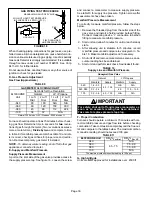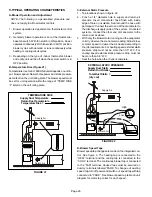
Page 22
Cleaning the Heat Exchanger and Burners
NOTE - Use papers or protective covering in front of the fur
nace during cleaning.
1 - Turn off both electrical and gas power supplies to fur
nace.
2 - Remove flue pipe and top cap
(some applications top
cap can remain
) from the unit.
3 - Label the wires from gas valve, thermal switch, primary
limit switch and make-up box then disconnect them.
4 - Remove the screws that secure the combustion air in
ducer to the collector box.
5 - Disconnect gas supply piping. Remove the screw se
curing the air fuel plenum and remove along with the air
inake assembly as one component.
6 - Remove screws from both sides, top and bottom of
vestibule panel.
7- Remove heat exchanger. It may be necessary to
spread cabinet side to allow more room. If so, remove
five screws from the left side or right side of cabinet.
See figure 24.
8-
Back wash using steam. Begin from the burner opening
on each tube. Steam must not exceed 275°F.
9- To clean burner, remove from the air gas plenum and run
a vacuum cleaner over the face of burner. Visually in
spect inside the burner for any blockage caused by for
eign matter. Remove any blockage. Figure 23 shows
burner detail. Replace gasket between burner plate and
air fuel plenum then re-install burner plate.
10- To clean the combustion air inducer visually inspect and
using a wire brush clean where necessary. Use com
pressed air to clean off debris and any rust.
11- Reinstall heat exchanger in vestibule. (Replace the
five screws in the cabinet from step 10 if removed).
12- Reinstall the air fuel plenum and air intake assembly.
Re-install the combustion air inducer assembly. Make
note to re-install all screws. Failure to replace all screws
may cause leaks.
13- Reconnect all wires.
14- Reconnect top cap and vent pipe to combustion air in
ducer outlet.
15- Reconnect gas supply piping.
16- Turn on power and gas supply to unit.
17- Set thermostat and check for proper operation.
18- Check all piping connections, factory and field, for gas
leaks. Use a leak detecting solution or other preferred
means.
CAUTION
Some soaps used for leak detection are corrosive to
certain metals. Carefully rinse piping thoroughly af
ter leak test has been completed. Do not use
matches, candles, flame or other sources of ignition
to check for gas leaks.
19- If a leak is detected, shut gas and electricity off and
repair leak.
20- Repeat steps 24 and 26 until no leaks are detected.
21- Replace access panel.






































